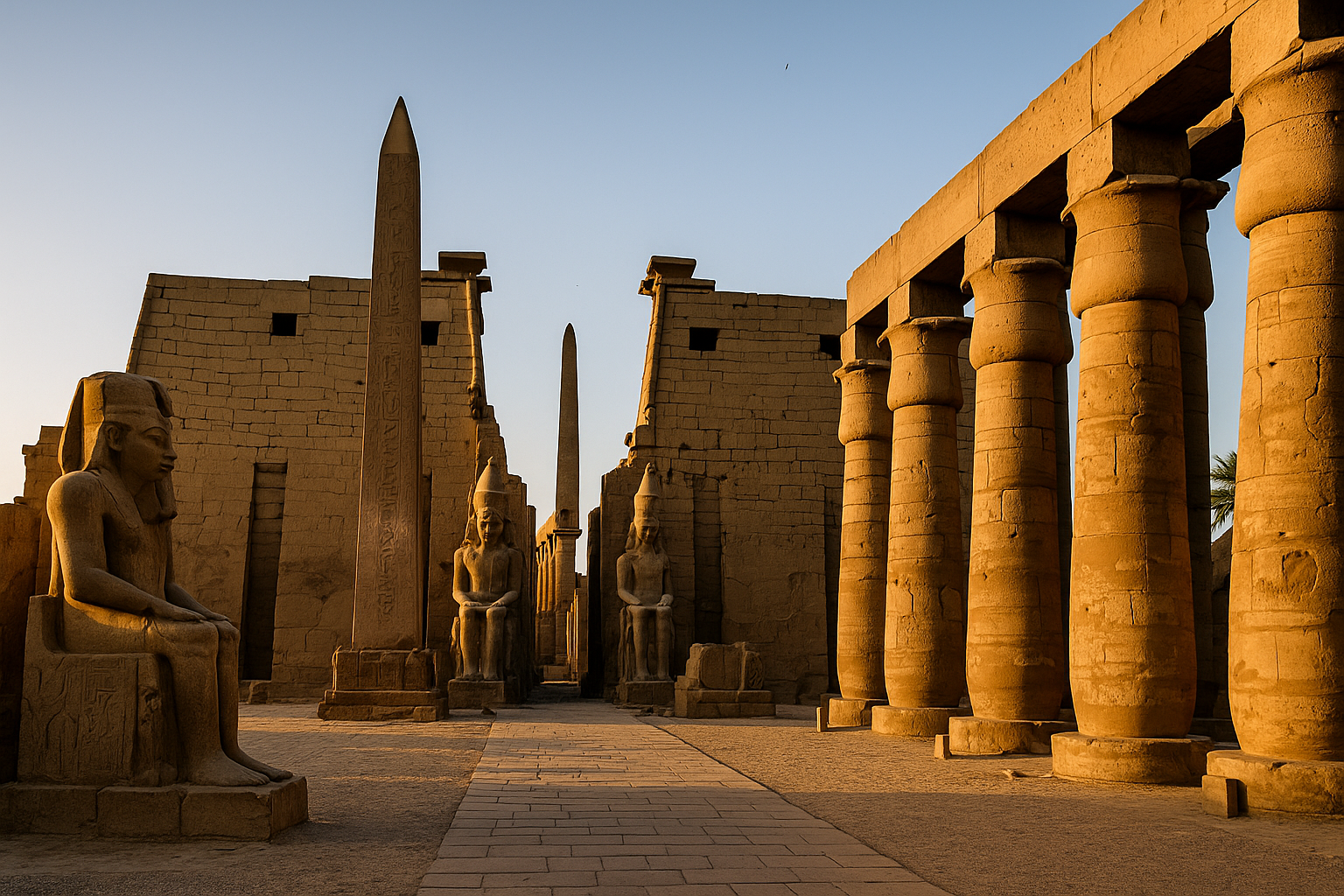In the city of Luxor—once known as Thebes—stands one of Egypt’s most captivating ancient wonders: Luxor Temple. This grand monument, located on the east bank of the Nile, is more than just a temple. It’s a living canvas of Egypt’s powerful dynasties, spiritual ceremonies, and architectural genius.
Whether you’re fascinated by ancient history or seeking a soul-stirring travel experience, Luxor Temple is a must-see site that holds the secrets of pharaohs, gods, and timeless rituals.
Why Luxor Temple is Unique
Unlike most temples in Egypt that were dedicated exclusively to a god or a divine cult, Luxor Temple was dedicated to the concept of kingship. It was the spiritual stage for the Opet Festival, where pharaohs were symbolically reborn each year.
Built primarily by Amenhotep III and expanded by Ramses II, Luxor Temple showcases a seamless blend of New Kingdom architecture and later additions, including elements added by Alexander the Great and even Romans. Yes, Luxor Temple spans multiple empires—making it a layered experience for visitors.
What to See Inside Luxor Temple
When you step inside Luxor Temple, you’re greeted by:
- Colossal Statues of Ramses II: Towering figures flanking the entrance, these statues exude majesty and power.
- First Pylon: Decorated with scenes of Ramses’ military victories.
- Great Court of Ramses II: Surrounded by 74 papyrus-shaped columns—perfectly symmetrical and awe-inspiring.
- Colonnade of Amenhotep III: A row of 14 massive columns, each intricately carved with scenes of pharaonic rituals.
- Sanctuary of Amun: The holiest part of the temple, where sacred rituals once took place.
- Roman Frescoes: Surprisingly, a small section of the temple includes Roman artwork from when the temple was converted into a church.
Each part of Luxor Temple tells a story—and every stone feels alive with memory.
The Avenue of Sphinxes: Linking Karnak and Luxor
A 3-kilometer ceremonial road once connected Luxor Temple to the nearby Karnak Temple. Known as the Avenue of Sphinxes, it was used during the Opet Festival, as priests and pharaohs paraded between the temples.
Today, you can walk along the restored pathway, imagining the music, incense, and chants that once echoed through this sacred route.
Want to see both temples in one trip? Browse our Classical Egypt Tours for packages that cover these breathtaking sites.
Luxor Temple at Night: A Spectacle of Light and Shadow
While impressive by day, Luxor Temple becomes magical by night. The entire complex is illuminated, casting dramatic shadows and emphasizing the temple’s majestic features.
A nighttime visit reveals new textures and perspectives, making the carvings and columns even more striking under the glow of artificial light. For photographers and romantics alike, this is a can’t-miss moment.
The Historical and Architectural Significance of Luxor Temple
The history of Luxor Temple begins with Pharaoh Amenhotep III in the 14th century BCE. He envisioned a sanctuary that would honor the rejuvenation of kingship, rather than just the worship of gods. This distinction makes Luxor Temple unique in Egypt’s religious architecture.
Amenhotep III’s original construction included the inner sanctuaries, the colonnade, and a courtyard. His vision was later expanded by Ramses II, who added monumental statues, the grand entrance pylon, and obelisks (one of which now stands in Paris at the Place de la Concorde).
Later rulers—including Tutankhamun, Alexander the Great, and Roman emperors—added their marks to the site. The layering of architectural styles across centuries makes Luxor Temple a fascinating study in continuity and transformation.
The design of Luxor Temple is strikingly linear, leading visitors through a sequence of gates, columns, and open spaces that reflect both ceremonial function and symbolic alignment. The temple’s axis once aligned with the sunrise, linking it cosmically to the divine.
One standout feature is the Colonnade of Amenhotep III—a corridor of 14 towering columns, each 52 feet high, decorated with carvings of festivals, rituals, and offerings. The proportions and symmetry of this structure reflect the architectural genius of the time.
The construction materials—sandstone from nearby quarries—were transported via the Nile and carved on-site by highly skilled artisans. The precision of the carvings, many of which still retain their original pigment, demonstrates both technical mastery and deep devotion.
How to Visit Luxor Temple
Located in the center of Luxor, the temple is easily accessible and often included in day tours. You can explore it with our:
Guided by professional Egyptologists, you’ll gain rich insights into the temple’s design, symbolism, and historical context.
Final Thoughts: A Must-See in Any Egyptian Journey
If the Pyramids are Egypt’s crown, then Luxor Temple is its beating heart. From its massive courtyards to its symbolic sanctuaries, this temple offers one of the richest and most engaging historical experiences in the world.
Whether you’re crafting a luxury escape or an affordable adventure, Luxor Temple deserves a front-row seat in your Egypt itinerary.
Start your journey today with Delta Tours Egypt and let history welcome you through the gates of Luxor Temple.
Plan your visit now at www.deltatoursegypt.com


Comment (0)